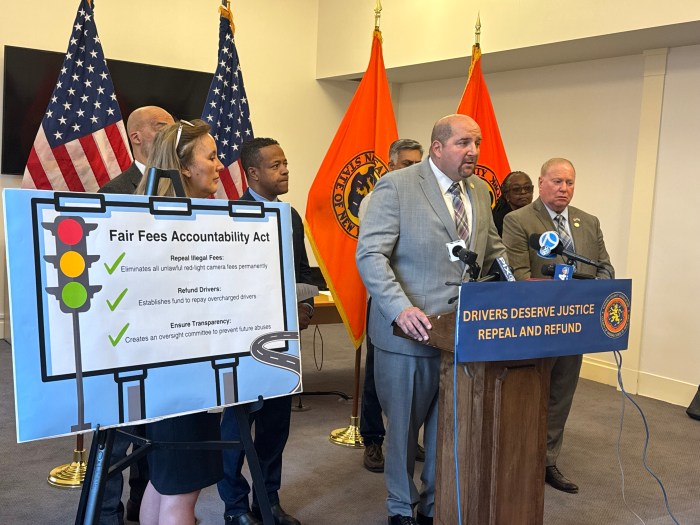
In 2012, Tesla and SpaceX CEO Elon Musk proposed the Hyperloop, a solar-powered, tubular steel train that uses vacuum and maglev technology to levitate above its tracks while traveling passengers and cargo twice as fast as a plane. Although he penned a 57-page manifesto on the brainchild the following year, Musk did not provide any technological blueprints, abdicating that initiative to anyone and everyone.
Among the denizens of the curious and the industrious? Thirteen-year-old Garden City Middle School student Caroline Crouchley, who recently designed a model of Hyperloop that may be more economically viable and environmentally friendly than Musk’s.
Crouchley’s design, which merited second place in the prestigious 3M Young Scientist Challenge in St. Paul, MN, features pneumatic tubes next to the train tracks, through which the shuttles would travel while linked magnetically to trains already traveling on the tracks. This model, which Crouchley developed with the help of 3D software program Autodesk Inventor, would still utilize existing train tracks, dramatically reducing the cost of infrastructure and the possible hazard posed by prior conceptions of Hyperloop having people travel at a cool 700 mph in low pressure.
Sound futuristic? It is: many experts doubt it will ever be implemented. Essentially, this advanced mode of transport rids two huge impediments to lightning-fast travel, which are air resistance and friction. In removing the latter, the train hovers above the tracks, analogous, Musk originally asserted, to a puck on an air hockey table, except the air would come out of the puck instead. In fact, his conception of Hyperloop included little jets of air, and has since been theoretically improved to replace those jets with the magnetic levitation system Crouchley based her model upon. Whereas most maglev systems rely on a gluttony of power (and money), this system affixes permanent magnets to the tubular pod, magnets that create a field when they move over the track’s conductive parts, rendering the need for an electrical current unnecessary. Furthermore, Hyperloop adds another magnet system to give the train a push every now and then, eliminating the need for it to be constantly propelled.

In terms of air resistance, the tube’s enclosure through the space in which the pods shoot through allows for vacuums to siphon out all the air, ensuring that the train would meet little resistance, making it incredibly fast, efficient and perhaps cheap. And Crouchley’s model might even be better than that, given its aforementioned improvements in safety and cost effectiveness.
And like other iterations of Hyperloop, her super train needs not diesel engines or electric motors, thereby decreasing greenhouse gas emissions and increasing efficiency. In fact, it would run on 100 percent renewable energy. This is paramount to Crouchley, who pointed to the increasingly dire state of the environment as well as her family’s lifestyle as major inspirations for invention.
“There’s a lot of global warming going on right now and since we’re on Long Island, [people need] the LIRR, and my brother and my dad go into the city every day,” Crouchley said. “Because trains aren’t really efficient, more people use cars and trucks and buses, if we used renewable energy, more people would take the train, and we wouldn’t pollute the air.”
One can imagine how arduous a process it was to design something of this technological magnitude: the precocious Crouchley perused a vast amount of esoteric scientific information to increase her understanding a thousandfold, manifested it on paper and translated it to Autodesk Inventor, all while maintaining her vision within the parameters of practicality. Not really an exact science.
“I thought there were ups and downs that I went through,” Crouchley said. “Some parts were more fun than the others…you’re learning as you’re going on.”
Crouchley emphasized how supportive her family and mentors were in the process, as well as how inspired she was by attending the 3M Young Scientist Challenge, whose thousands of applicants—students in grades 5 through 8, only 10 of whom including Crouchley became finalists—described their solution to a particular everyday problem in a short video. “I thought it was really fun,” Crouchley said. “I got to meet a lot of kids that like science, and I thought all of their inventions were really cool.”
So what’s next for the bright middle schooler? Creating a bigger, better prototype in order to extrapolate her concepts to a larger scale. In the wake of her recognition, Crouchley noted in an October interview that she wants to start a conversation about how existing infrastructure can be redesigned to accommodate renewable energy machinery sooner rather than later. Distributing her project to engineers, scientists and prestigious universities so they can spearhead the mathematics and physics behind her idea is another vital prerogative. But if Crouchley’s early success is any indication, the unlikely may soon become reality.




























